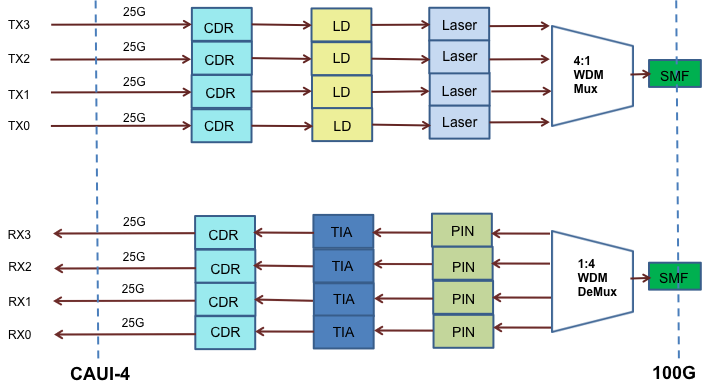It’s no denying that today’s data centers are moving from 10G to 40G and 100G quickly. On this road, data explosion is getting faster, which result in great demand for cost-effective 100G optics. And the commonly used 100G qsfp28 transceiver are CFP, CFP2, CFP4 and QSFP28, especially the QSFP28. Today this article mainly introduces four types of 100G QSFP28 transceiver and the comparison between them to help you choose a suitable one.
The 100G SR4 transceiver is a full-duplex optical module, offering four independent transmit and receive channels, each capable of 25Gb/s operation for an aggregate data rate of 100Gbps to 100 meters on OM4 multimode fiber (MMF). It’s fully compliant with QSFP28 Multi-Source Agreement (MSA) and can offer increased port density and total system cost savings for future data center and networking use. When connected to transmission links, an optical fiber ribbon cable is plugged into the QSFP28 modules receptacle via the MTP/MPO connector, and the guide pins inside the receptacle ensure the proper alignment. Besides, this QSFP28 transceiver offers high functionality and feature integration, accessible via a two-wire serial interface which is available for more complicated control signals and digital diagnostic information.

The 100G LR4 transceiver is a fully integrated 4x25Gbit/s optical transceiver module, designed for use in data centers and high performance computing network links on up to 10km of single mode fiber (SMF). They are compliant with QSFP28 MSA, IEEE 802.3ba and IEEE 802.3bm CAUI-4. When connected to data transmission links, it converts four input channels of 25Gb/s electrical data to four channels of LAN WDM optical signals and then multiplexes them into a signal channel for 100Gb/s optical transmission. While on the receiver side, the module demultiplexes the 100G optical signals into four output channels and converts them into electrical data.

Defined by the 100G PSM4 MSA, qsfp 100g psm4 s is a little different from 100g SR4 transceiver. It uses four parallel lanes (four transmit and four receive) operating on each direction. Each lane carries 25G optical transmission. Therefore, eight single mode fibers are needed when PSM4 is deployed in transmission links. And the reach of PSM4 is up to 500m on single mode fiber, compensating for the transmission distance defect between 100g SR4 and 100g LR4 transceiver.

CWDM4 routes four 25G optical transmissions down a single fiber, which is like the qsfp 100g psm4 s. But it has longer reaches of up to 2km on SMF. And CWDM4 uses multiplexer and de-multiplexer to reduce the number of fibers to two rather than eight. When connected into transmission links, on the transmitting side, signals are multiplexed into one channel and transmitted through the SMF; then on the receiving side, the incoming signals are demultiplexed into four separated channels (shown as below).

With a number of 100G optical transceivers emerged, many factors should be taken into consideration when choose suitable transceivers. The key features of the 100G QSFP28 transceivers are listed below.

As shown in the table, cable type, interface type, fiber count and reach are needed to be considered when purchasing transceivers. For example, in the terms of reach, except the shortest (100g SR4) and the longest (100g LR4), qsfp 100g psm4 s and CWDM4 are battling out in the 2km range. Here is a simple chart that may help to illustrate the difference between the two. As have mentioned above, qsfp 100g psm4 s doesn’t use MUX/DEMUX, which determines its price is lower than CWDM4. However, as the transmission distance increases, the cost will grow quickly since it deploys eight-fiber transmission links.

In summary, there are various types of 100G qsfp28 transceiver modules on the market. Different companies and operators have different requirements for their links and applications. So choosing a suitable 100G QSFP28 transceiver should be based on your practical situations. If you want to know more about 100G QSFP28 transceivers, welcome to visit FS.COM.
